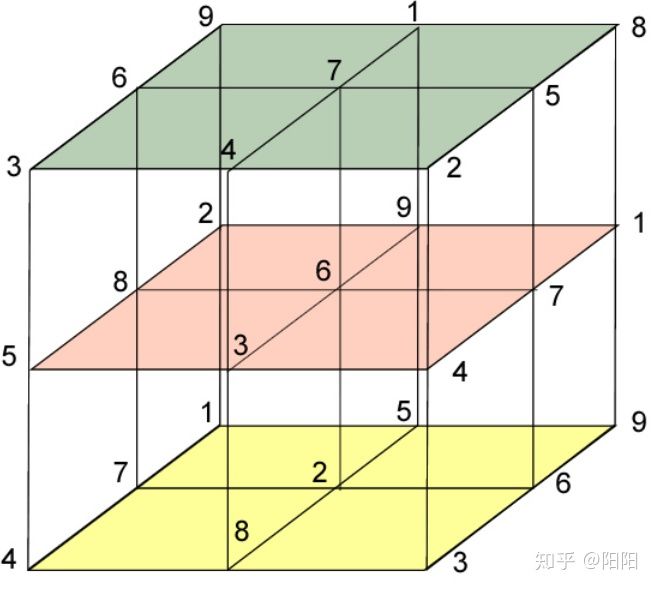Tensors
What is Tensors?
Tensors are a specialized data structure that are very similar to arrays and matrices. In PyTorch, we use tensors to encode the inputs and outputs of a model, as well as the model’s parameters.
Tensors are similar to NumPy’s ndarrays, except that tensors can run on GPUs or other specialized hardware to accelerate computing.
张量(tensor) 可以和之前学的矢量和矩阵相联系。
- 0阶张量是一个数
- 1阶张量是一个矢量(vector),计算机中就可以用一位数组表示
- 2阶张量是一个矩阵
- ……
下面是一个3阶张量:
[
[[9,1,8],[6,7,5],[3,4,2]],
[[2,9,1],[8,6,7],[5,3,4]],
[[1,5,9],[7,2,6],[4,8,3]]
]
中间的每一行都是一个矩阵(2阶张量)
另外,3阶张量又叫”空间矩阵“或者”三维矩阵“,例如:

Tensor Initialization
Directly from data
Tensors can be created directly from data. The data type is automatically inferred.
data = [[1,2,3],[4,5,6],[7,8,9]]
x_data = torch.tensor(data)
OUt:
tensor([[1, 2, 3],
[4, 5, 6],
[7, 8, 9]])
From a NumPy array
Tensors can be created from NumPy arrays.
data = [[1,2,3],[4,5,6],[7,8,9]]
np_array = np.array(data)
x_np = torch.from_numpy(np_array)
print(x_np)
Out:
tensor([[1, 2, 3],
[4, 5, 6],
[7, 8, 9]], dtype=torch.int32)
And vica versa, NumPy arrays can also be created from tensors.
data = [[1,2,3],[4,5,6],[7,8,9]]
x_t = torch.tensor(data)
np_array = x_t.numpy()
print(np_array)
Out:
[[1 2 3]
[4 5 6]
[7 8 9]]
Tensors on the CPU and NumPy arrays can share their underlying memory locations, and changing one will change the other.
t = torch.ones(5)
print(f"t: {t}")
n = t.numpy()
print(f"n: {n}")
Out:
t: tensor([1., 1., 1., 1., 1.])
n: [1. 1. 1. 1. 1.]
A change in the tensor reflects in the NumPy array.
t.add_(1)
print(f"t: {t}")
print(f"n: {n}")
Out:
t: tensor([2., 2., 2., 2., 2.])
n: [2. 2. 2. 2. 2.]
From another tensor
除非显式更改,新创建的张量会保持原张量的性质(性状、数据类型)。
The new tensor retains the properties (shape, datatype) of the argument tensor, unless explicitly overridden.
x_ones = torch.ones_like(x_data) # retains the properties of x_data
print(f"Ones Tensor: \n {x_ones} \n")
x_rand = torch.rand_like(x_data, dtype=torch.float) # overrides the datatype of x_data
print(f"Random Tensor: \n {x_rand} \n")
Out:
Ones Tensor:
tensor([[1, 1],
[1, 1]])
Random Tensor:
tensor([[0.1148, 0.1487],
[0.0268, 0.5634]])
With random or constant values
shape决定张量的维度。
shape is a tuple of tensor dimensions. In the functions below, it determines the dimensionality of the output tensor.
shape = (2, 3,)
rand_tensor = torch.rand(shape)
ones_tensor = torch.ones(shape)
zeros_tensor = torch.zeros(shape)
print(f"Random Tensor: \n {rand_tensor} \n")
print(f"Ones Tensor: \n {ones_tensor} \n")
print(f"Zeros Tensor: \n {zeros_tensor}")
Out:
Random Tensor:
tensor([[0.3085, 0.9156, 0.5904],
[0.0319, 0.0674, 0.5835]])
Ones Tensor:
tensor([[1., 1., 1.],
[1., 1., 1.]])
Zeros Tensor:
tensor([[0., 0., 0.],
[0., 0., 0.]])
Tensor Attributes
Tensor attributes describe their shape, datatype, and the device on which they are stored.
tensor = torch.rand(3, 4)
print(f"Shape of tensor: {tensor.shape}")
print(f"Datatype of tensor: {tensor.dtype}")
print(f"Device tensor is stored on: {tensor.device}")
Out:
Shape of tensor: torch.Size([3, 4])
Datatype of tensor: torch.float32
Device tensor is stored on: cpu
Tensor Operations
Move our tensor to the GPU
# We move our tensor to the GPU if available
if torch.cuda.is_available():
tensor = tensor.to('cuda')
print(f"Device tensor is stored on: {tensor.device}")
Out:
pyDevice tensor is stored on: cuda:0
Standard numpy-like indexing and slicing:
tensor = torch.ones(4, 4)
tensor[:,1] = 0
print(tensor)
Out:
tensor([[1., 0., 1., 1.],
[1., 0., 1., 1.],
[1., 0., 1., 1.],
[1., 0., 1., 1.]])
Joining tensors
You can use
torch.catto concatenate a sequence of tensors along a given dimension.
t1 = torch.cat([tensor, tensor, tensor], dim=1)
print(t1)
Out:
tensor([[1., 0., 1., 1., 1., 0., 1., 1., 1., 0., 1., 1.],
[1., 0., 1., 1., 1., 0., 1., 1., 1., 0., 1., 1.],
[1., 0., 1., 1., 1., 0., 1., 1., 1., 0., 1., 1.],
[1., 0., 1., 1., 1., 0., 1., 1., 1., 0., 1., 1.]])
Multiplying tensors
张量中对应元素相乘。
# This computes the element-wise product
print(f"tensor.mul(tensor) \n {tensor.mul(tensor)} \n")
# Alternative syntax:
print(f"tensor * tensor \n {tensor * tensor}")
Out:
tensor.mul(tensor)
tensor([[1., 0., 1., 1.],
[1., 0., 1., 1.],
[1., 0., 1., 1.],
[1., 0., 1., 1.]])
tensor * tensor
tensor([[1., 0., 1., 1.],
[1., 0., 1., 1.],
[1., 0., 1., 1.],
[1., 0., 1., 1.]])
矩阵乘法
print(f"tensor.matmul(tensor.T) \n {tensor.matmul(tensor.T)} \n")
# Alternative syntax:
print(f"tensor @ tensor.T \n {tensor @ tensor.T}")
Out:
tensor.matmul(tensor.T)
tensor([[3., 3., 3., 3.],
[3., 3., 3., 3.],
[3., 3., 3., 3.],
[3., 3., 3., 3.]])
tensor @ tensor.T
tensor([[3., 3., 3., 3.],
[3., 3., 3., 3.],
[3., 3., 3., 3.],
[3., 3., 3., 3.]])
In-place operations
Operations that have a
_suffix are in-place. For example:x.copy_(y),x.t_(), will changex.
in-place指的是”就地“,也就是操作过后会改变x。
print(tensor, "\n")
tensor.add_(5)
print(tensor)
Out:
tensor([[1., 0., 1., 1.],
[1., 0., 1., 1.],
[1., 0., 1., 1.],
[1., 0., 1., 1.]])
tensor([[6., 5., 6., 6.],
[6., 5., 6., 6.],
[6., 5., 6., 6.],
[6., 5., 6., 6.]])





















 5698
5698











 被折叠的 条评论
为什么被折叠?
被折叠的 条评论
为什么被折叠?








